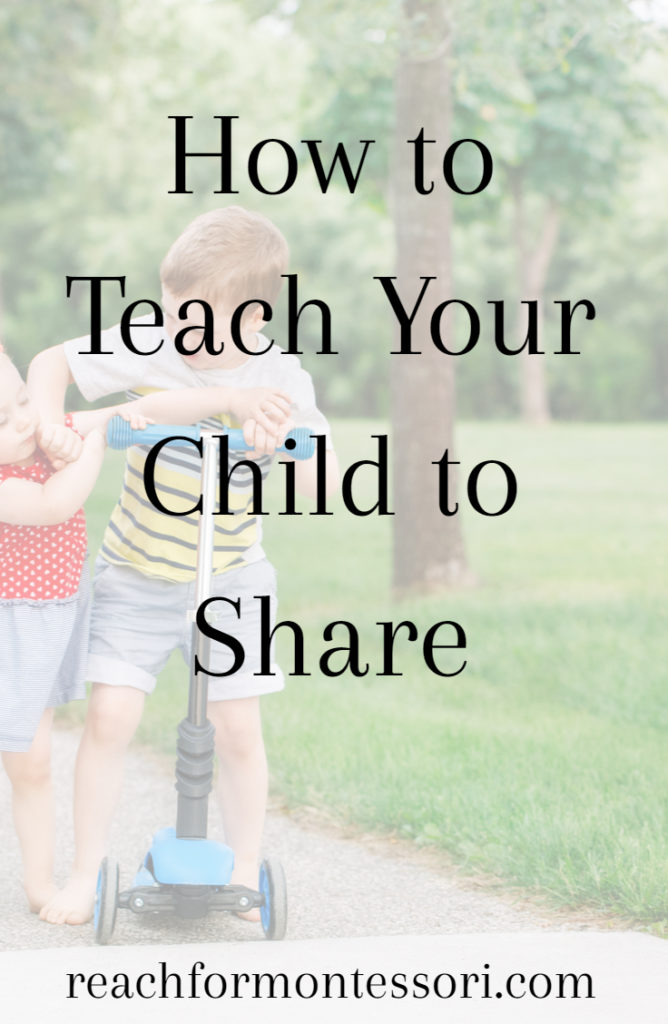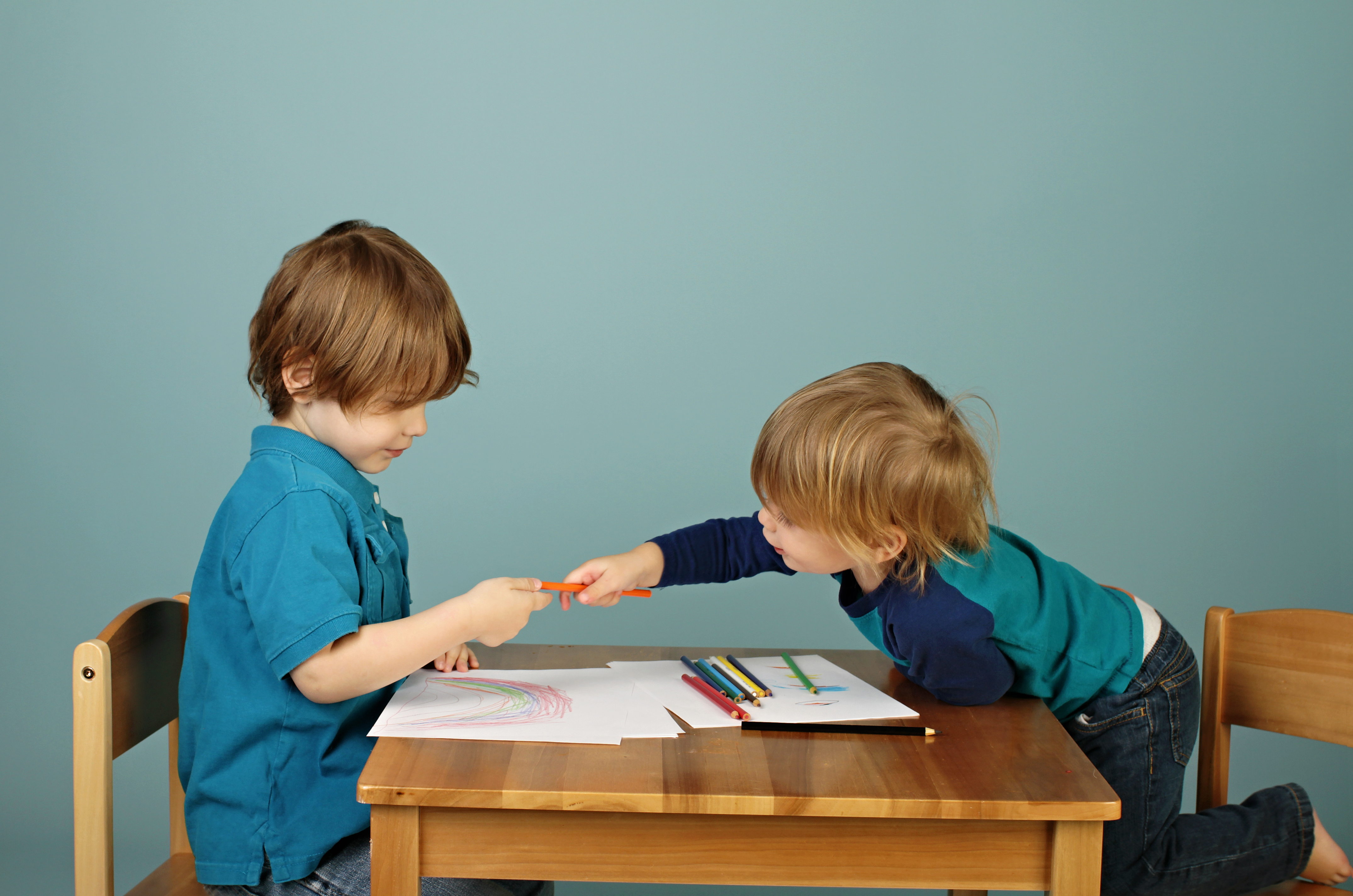Having a peaceful, harmonious home life or playdate is often dependent on one thing for parents of young children – sharing. The question is as old as time. How can we teach kids how to share?
There are different views on the terminology, but whether you choose to use the term “taking turns” or “sharing“, you are teaching your children essentially the same thing; kindness and compassion in their interactions with others.

At what age do kids understand the concept of sharing?
The ability to share toys with other kids is actually developmental. We see the ability to willingly, and even joyfully share, happen around the time wherein empathy develops.
What empathy looks like in children:
- He understands that he is an individual, as are others, and that other kids may feel and think differently from him.
- He recognizes and can name his emotions.
- He has physical control over his emotional responses.
- He can consider what other people might be feeling.
- He can come up with ways to try to help others feel better.
So, being able to share involves a lot more than simply handing a toy over to a sibling or friend or getting off the swing at the park so another child can have a turn for a young child. The emotional intelligence and empathy need to be present.
We start to see signs of empathy budding in children as young as 2 years old, but that doesn't mean they are developmentally ready to share.
Closer to the end of the first plane of development (or around 6 years old) is when we see kids demonstrating the empathic qualities listed above.
This doesn't mean every 3 year old is incapable of sharing, or that every 10 year old is empathetic. Every child matures at a different pace and factors such as genetics and environment play roles in when children develop empathy.
There are things we can do to help a child develop their emotional intelligence, though. Simply “waiting it out” does not guarantee a child will be empathetic and sharing by a particular age, or ever.

Teach kids how to share
Now we you understand the mechanism behind sharing, let's find out what we can do to teach kids how to share.
1. Model sharing
This is the easiest and most helpful thing we can do when trying to get our young kids to share! Our kids are always following us and trying to do everything we do.
So, why not cash in on this and show them what sharing looks like?
You can share things with your spouse, friends, and your child. “I am going to let daddy have a turn with the newspaper after I am done reading this article.” or “I see you are finished with your dessert. I know how much you like banana bread. I can share some of mine with you!“
There is no need to set up elaborate role-playing scenarios for this. Just weave the theme into your daily life.
This not only helps develop your child's ability to share, but it can serve as a reminder to parents that, as draining as parenting can be sometimes, a little extra kindness can make all the difference!
2. Use a timer for sharing

When we teach kids how to share, there is no more helpful tool than a timer. We use our Amazon Alexa in our house (“Alexa, set “train timer” for 2 minutes”).
An egg timer works just fine, too. Also, we all have stop watches on our cellphones now. When we are at a playdate or outside, that is always an option.
It may take several cycles of taking turns, but 2 minutes is a reasonable amount of time for these practice exercises.
The reasoning behind practicing like this is your child is likely to be in situations wherein the are going to have to take turns and/or share. Shielding them from this reality hinders their development of the emotional intelligence needed for sharing and it is likely to cause a whole lot of extra stress for everyone when they are finally put in the position to give someone else a turn on that swing set we mentioned earlier.
While you perform the exercises with the timer, make sure to use empathetic language with each child to help them identify their own feelings and the feelings of the other child.
3. Practice makes…better
As with any skill, children need to be given ample opportunities to develop the ability to share.
Sharing happens when we split a sandwich in half at the park so our friend can have some. It happens when we scoot over on the park bench to make room for someone else.
Practical life activities are also great opportunities to practice sharing.
When your child is cutting strawberries or stirring cake batter, jump in and ask if you can have a turn. If your child is transferring laundry from the washer to the dryer, use that time to practice taking turns.
Chances to practice sharing are all around us!
4. Pack a few toys
Have you ever marveled at how your child has a house full of toys, but is still drawn to a single toy brought over by another child? (Read for tips on keeping your child's toys “new” to them here!)
The allure of other people's things is especially strong in young children. It's a great idea to take advantage of this to teach kids to share their own things.
How does this work?
Simply pack a few of your child's toys when you are going to be around other kids. When the other kids see your child's toys, they are going to want to check them out.
And your child will likely take a shining to some toys he sees, too.
This is a great opportunity to talk to your child about how it feels to have people share with him and an opportunity to talk about how it feels when he see's how happy others are to get a chance to play with his toys.
5. Natural consequences
I've written about natural consequences before. I'm a firm believer that parents, teachers, and other caregivers do not need to be actively involved in imposing consequences for many behaviors.
And that often the lessons life has to teach are richer and have a greater impact on kids.
We can apply this to sharing by simply standing back for a while when a toy disagreement is taking place between kids. As long as there is not toddler violence taking place, observe how the situation plays out.
You may be surprised to find that if you stand back for an extra minute or two, the kids may figure things out on their own.
This may look like:
- The children coming to a compromise about who will use the toy or how they can both use it in their play.
- One child may decide that it is not fun to play with someone who doesn't share. The child who was having trouble sharing may realize that his behavior caused the other child to play somewhere else.
- One of the children will learn that it is not fun to have someone try to repeatedly snatch his toy and find his own voice in saying, “No. It's still my turn.”
When is it okay to NOT share?
There are circumstances when it is perfectly okay for kids to not share.

Many children develop attachments to stuffed animals or other toys. These toys are viewed by young children as being extensions of themselves or their parents.
Under no circumstance should a child be asked to even practice sharing using an attachment item.
Also, no child should be encouraged to share something they need or something that could cause harm to the child they are sharing with. Being kind to others is a human imperative, but it should never come at the expense of a child's safety or health.
What would your advice be if someone asked you, “How do you teach kids how to share?“.
Cheers and don't forget to subscribe!
